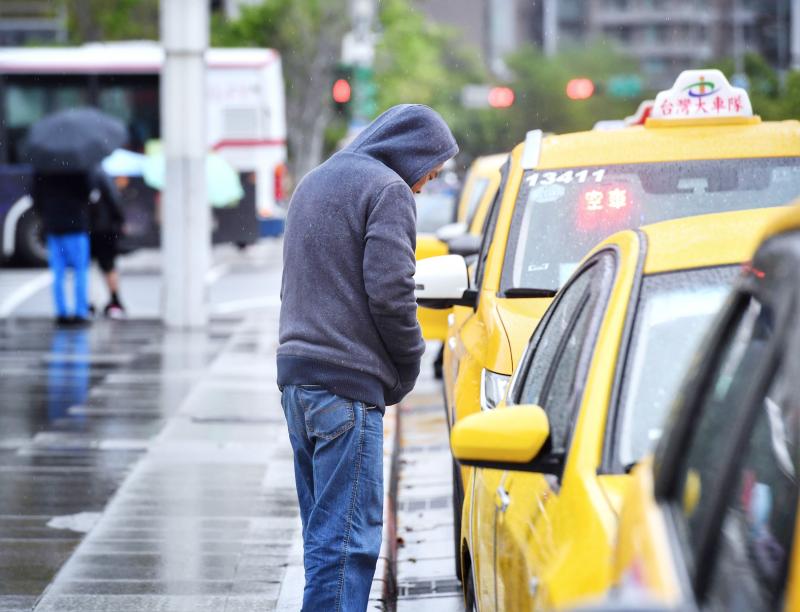Even with more than NT$450 billion (US$14.85 billion) in financial aid from the Executive Yuan’s expanded relief package, local tourism-related businesses are unlikely to rebound from the COVID-19 pandemic any time soon, a central bank report released last month said.
The NT$1.05 trillion relief package includes NT$472 billion in financial assistance for tourism and transportation sectors, such as airlines, hotels, travel agencies, taxis and tour buses.
However, a March 20 central bank report said that the effects of the COVID-19 pandemic on global and domestic economies are far greater than that of the 2002-2003 SARS epidemic, despite any benefits from delayed purchases after the crisis ends.

Photo: CNA
Tourism-related industries would be hardest hit, with widespread travel restrictions and bans on mass gatherings imposed by governments worldwide.
“It is difficult to say that there will be a V-shaped recovery at the moment, as it all depends on the development of the pandemic,” the report said.
Taking the SARS epidemic that broke out in late 2002 as an example, the bank said that the local economy rapidly lost momentum in the second quarter of 2003 after the disease took its toll on global activity.
Over that three-month period, travel on international flights to and from Taiwan fell 69.5 percent and the nation’s economy contracted 1.15 percent in 2003 as a result of the knock-on effects of SARS, the bank said, adding that the effects of COVID-19 are more severe.
Passenger load factors in February on routes between Taiwan and China, Hong Kong and Macau fell by more than 90 percent, compared with their levels in December last year, the report said, citing Tourism Bureau statistics.
At the same time, taxi drivers had 30 percent fewer passengers, while tour bus operators also experienced a 17.2 percent decline in daily operations from January, the report said.
The central bank said that the restaurant and beverage sector typically has the highest GDP ratio from the tourism industry, while tour agencies, hotels, and car rental and air transportation companies also earn a noticeable portion of their incomes from it.
Therefore, as domestic and foreign tourists’ travel activities stagnate in Taiwan, tourism-related businesses would face greater difficulties, the bank said.
Due to Taiwanese’s strong interest in traveling abroad, coupled with Beijing’s ban on independent tourists to Taiwan from Aug. 1 last year, Taiwan registered travel deficits of US$6.1 billion last year, a new high, central bank data showed.
However, the travel deficits would likely shrink this year, because of COVID-19, the bank said.

Shiina Ito has had fewer Chinese customers at her Tokyo jewelry shop since Beijing issued a travel warning in the wake of a diplomatic spat, but she said she was not concerned. A souring of Tokyo-Beijing relations this month, following remarks by Japanese Prime Minister Sanae Takaichi about Taiwan, has fueled concerns about the impact on the ritzy boutiques, noodle joints and hotels where holidaymakers spend their cash. However, businesses in Tokyo largely shrugged off any anxiety. “Since there are fewer Chinese customers, it’s become a bit easier for Japanese shoppers to visit, so our sales haven’t really dropped,” Ito

The number of Taiwanese working in the US rose to a record high of 137,000 last year, driven largely by Taiwan Semiconductor Manufacturing Co’s (TSMC, 台積電) rapid overseas expansion, according to government data released yesterday. A total of 666,000 Taiwanese nationals were employed abroad last year, an increase of 45,000 from 2023 and the highest level since the COVID-19 pandemic, data from the Directorate-General of Budget, Accounting and Statistics (DGBAS) showed. Overseas employment had steadily increased between 2009 and 2019, peaking at 739,000, before plunging to 319,000 in 2021 amid US-China trade tensions, global supply chain shifts, reshoring by Taiwanese companies and

Taiwan Semiconductor Manufacturing Co (TSMC, 台積電) received about NT$147 billion (US$4.71 billion) in subsidies from the US, Japanese, German and Chinese governments over the past two years for its global expansion. Financial data compiled by the world’s largest contract chipmaker showed the company secured NT$4.77 billion in subsidies from the governments in the third quarter, bringing the total for the first three quarters of the year to about NT$71.9 billion. Along with the NT$75.16 billion in financial aid TSMC received last year, the chipmaker obtained NT$147 billion in subsidies in almost two years, the data showed. The subsidies received by its subsidiaries —

Taiwan Semiconductor Manufacturing Co (TSMC) Chairman C.C. Wei (魏哲家) and the company’s former chairman, Mark Liu (劉德音), both received the Robert N. Noyce Award -- the semiconductor industry’s highest honor -- in San Jose, California, on Thursday (local time). Speaking at the award event, Liu, who retired last year, expressed gratitude to his wife, his dissertation advisor at the University of California, Berkeley, his supervisors at AT&T Bell Laboratories -- where he worked on optical fiber communication systems before joining TSMC, TSMC partners, and industry colleagues. Liu said that working alongside TSMC